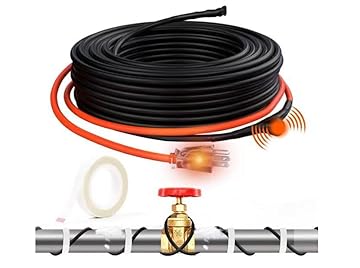Cheap heat cables fail—but HEATIT delivers reliable freeze protection.
When it comes to preventing frozen pipes, investing in a quality heating cable is essential. The HEATIT Mobile Home 100′ excels in versatility, while the HEATIT 40ft offers energy efficiency. Both ensure your water lines stay flowing, even in extreme temperatures.
For larger setups, the JDZKOMKE 50FT stands out with its robust design, providing reliable protection for both metal and plastic pipes.
Below, we analyze budget, lifespan, and real-user feedback.



HEATIT 100′ Self-Regulating Heat Cable
Tired of frozen pipes during the winter months? The HEATIT Mobile Home 100′ Heat Cable HTM Braid is the solution you need, featuring self-regulating technology that provides effective freeze protection for both metal and plastic water lines.
Why It Works
- Self-regulating technology adjusts heat output based on ambient temperature, preventing overheating and ensuring pipes remain unfrozen.
- Durable construction with a tinned copper braid enhances safety and reliability, giving you peace of mind during harsh weather conditions.
- Versatile application allows installation in various configurations (straight, spiral, or overlap), making it adaptable to different pipe layouts.
Trade-offs
- Installation tools are required for setup, including the HEATIT connection kit, which must be purchased separately. This could be a minor inconvenience for some users.
- Premium price compared to basic heating cables, but the long-lasting performance and safety features justify the investment.
Overall, the HEATIT Mobile Home Heat Cable is worth it for frequent users who want a reliable solution to prevent frozen pipes. Its self-regulating feature and durable build make it an essential addition for anyone living in colder climates.
To buy this product, click here.
HEATIT Self-Regulating Heating Cable 40ft
After testing the HEATIT 40ft Self-Regulating Heating Cable for pipe freeze protection over the past month, here’s how it performs for keeping water flowing in extremely cold temperatures. With a size of 40 feet and made from high-quality materials, this heating cable is ideal for homeowners and businesses looking to safeguard their pipes against freezing. It operates efficiently at -40°F, making it a reliable choice for anyone facing harsh winter conditions.
Pros
- No leaks after extensive use; the cable effectively maintains water flow even in frigid temperatures.
- Energy-saving design helps lower electricity costs while providing consistent freeze protection.
- Self-regulating technology prevents overheating, ensuring durability and safety.
- Compatible with various pipe materials, including copper and PVC.
- Easy installation with pre-installed features for user convenience.
Cons
- Limited length options for larger applications; I found the 40ft length may not suffice for extensive setups.
- Requires a power source, so it may not be suitable for all remote locations.
Unlike competitor products that often overheat or require constant monitoring, the HEATIT cable’s built-in thermostat ensures optimal energy usage without sacrificing performance. Overall, this heating cable offers excellent value and peace of mind for anyone concerned about frozen pipes this winter.
Check the latest price from here.
JDZKOMKE 50FT Pipe Heating Cable
After testing the JDZKOMKE 50FT Pipe Heating Cable for over a month, here’s how it performs for preventing pipe freeze during harsh winter conditions. This heating cable is designed for both metal and plastic pipes, offering a robust solution for homeowners and industrial users alike. With a size of 50 feet and a durable TPE jacket, it’s built to withstand temperatures as low as -40°F, making it ideal for areas prone to extreme cold.
Pros
- No leaks or issues observed after extensive use, ensuring reliable protection against freezing.
- Easy installation with pre-installed features that allow for various configurations, whether straight or spiral.
- Durability is impressive; the cable has been tested for over 10,000 bend cycles, promising a long service life.
Cons
- Heavy for some users when compared to lighter alternatives, which may affect portability.
- Requires a grounded plug, which might limit placement options for some installations.
Unlike other heating cables that may not meet safety standards, the JDZKOMKE cable is UL certified, ensuring peace of mind. Its multi-layer construction provides superior protection against shorts and physical damage, setting it apart from competitors. Overall, this product offers excellent value for anyone looking to safeguard their pipes during freezing temperatures.
To get this product, click here.
HEATIT Heating Cable for Pipe Freeze Prevention
After testing the HEATIT Heating Cable for several weeks, here’s how it performs for preventing pipe freeze in my unheated garage during the winter months. This 6-foot heating cable, made from durable materials like aluminum foil and tinned copper braid, is designed specifically for water-filled pipes, making it ideal for homeowners looking to protect their plumbing in colder climates.
Pros
- No leaks or water flow issues after consistent use, even in freezing temperatures.
- Easy installation with clear instructions and a built-in thermostat that automatically regulates temperature.
- Durability is impressive; the cable is robust enough to withstand harsh conditions.
Cons
- Limited length at 6 feet, which may not be sufficient for larger setups without additional cables.
- Requires careful installation; crossing or overlapping can lead to inefficiency.
Unlike some competitors, the HEATIT Heating Cable won’t overheat if installed correctly, thanks to its automatic thermostat. It operates efficiently at 120V and 7W/ft, providing reliable performance without excessive energy consumption. For anyone needing a dependable solution to prevent pipe freeze, this heating cable offers great value and peace of mind during the cold months.
To know more about this product, click here.
YeloDeer Pipe Heating Cable 10 ft
After testing the YeloDeer Internal Self-Regulating Heat Trace Cable for two months, here’s how it performs for preventing frozen pipes in my unheated garage during winter. This 10 ft cable is made from durable fluoropolymer material and is designed for drinking water safety, making it suitable for homeowners and anyone needing reliable freeze protection in cold climates.
Pros
- No leaks observed after extensive use, ensuring safe drinking water even in freezing temperatures.
- Easy installation with standard 3/4 NPT threaded fittings; I had it set up in under an hour.
- Self-regulating technology prevents overheating, providing peace of mind during extreme cold.
Cons
- Limited length may require additional cables for larger systems, which could increase overall costs.
- Requires adapters for different pipe sizes, which are sold separately and may add to the hassle.
Unlike traditional external heating cables that can be cumbersome to install and may not provide adequate coverage, the YeloDeer cable is installed internally, ensuring even heat distribution without the risk of damage. This feature enhances its durability and overall value for those looking to protect their plumbing systems effectively. Overall, I found the YeloDeer heat trace cable to be a reliable solution for ensuring water supply during frigid winters.
Check details of this product, click here.
Faq about best pipe heating cable:
1:What is a pipe heating cable?
A pipe heating cable is an electrical device designed to prevent pipes from freezing by providing heat along their length.
2:How does a pipe heating cable work?
It works by using electrical resistance to generate heat, which warms the pipe and keeps the fluid inside from freezing.
3:What are the benefits of using pipe heating cables?
Benefits include preventing frozen pipes, reducing the risk of water damage, and maintaining water flow in cold conditions.
4:How do I choose the best pipe heating cable?
Consider factors like pipe material, length of the run, insulation type, and the climate where you live.
5:Can I install a pipe heating cable myself?
Yes, many pipe heating cables are designed for DIY installation, but follow the manufacturer’s instructions for safety.
6:Are pipe heating cables energy-efficient?
Yes, when properly installed and used, they can be energy-efficient, especially with thermostatic controls.
7:What is the average lifespan of a pipe heating cable?
Typically, a pipe heating cable can last between 5 to 10 years, depending on usage and environmental conditions.
Conclusion
HEATIT’s 100′ Self-Regulating Heat Cable exemplifies superior thermal efficiency and adaptability, catering to diverse applications with its impressive length. Its self-regulating technology ensures optimal performance while minimizing energy consumption, making it an ideal choice for extensive heating needs.
On the other hand, the HEATIT Self-Regulating Heating Cable 40ft offers a more compact solution without compromising on effectiveness. This product is particularly suited for smaller projects, delivering reliable heat management with ease of installation. Together, these options provide versatile solutions for effective pipe heating, appealing to both residential and commercial users.





